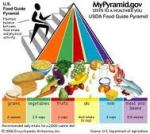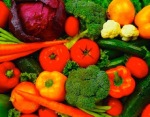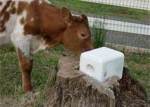Many people have asked me why I just don’t follow a healthy diet for my kidney disease. It’s one of those questions we hear again and again as early stage chronic kidney disease patients … and not just from those who think they know better, but from those who genuinely care about us and want to help. Today’s blog is meant to answer that question.
There were many food guides from the government before the introduction of the one we usually hear about, the USDA’s 1992 Food Pyramid. (See http://www.huffingtonpost.com/2011/06/02/usda-food for a fascinating history of the older ones if that interests you.) Although updated in 2005, this was the gold standard for a healthy diet. We’ll be dealing with the 2005 revised version in this blog.
Michelle Obama changed all that in 2011 when she supported MyPlate as the new U.S. nutrition guideline in an effort to help control the obesity epidemic. By then, I was already on the renal diet so didn’t really pay attention.
I wanted to use the government’s website since both Pyramid and MyPlate are their concepts, but since that wasn’t up due to the government shut down (didn’t expect to see that again in my lifetime), I relied on http://www.usaring.com/health/food/food.htm for information about the 2005 Pyramid and http://www.medicinenet.com/myplate/page2.htm#difference for the MyPlate information. The renal diet information is from the diet my own renal nutritionist helped formulate. 
So what are the differences you ask?
 Let’s start with the base of the Food Pyramid which includes 6 oz. of bread, cereal, rice and pasta a day with the stipulation that half of these be whole grain. Sounds like heaven for a miller’s grand-daughter like me. MyPlate suggests the same amounts. However, my renal diet considers a portion of pasta as 1/3 cup, not the ½ cup in the other two eating guides… however many calories a day I can eat.
Let’s start with the base of the Food Pyramid which includes 6 oz. of bread, cereal, rice and pasta a day with the stipulation that half of these be whole grain. Sounds like heaven for a miller’s grand-daughter like me. MyPlate suggests the same amounts. However, my renal diet considers a portion of pasta as 1/3 cup, not the ½ cup in the other two eating guides… however many calories a day I can eat.
That makes a difference because of the phosphorous and potassium CKD patients need to curb, to say nothing of our daily calorie limits. Even the protein adds up. For example, I’m limited to 60 grams of protein a day. That doesn’t mean just meat. My favorite angel hair pasta has 7 grams of protein for a 2 oz. serving. Let’s say I’d like half a cup. That’s 4 oz. and already 14 of my 60 protein grams. Got to save some of those protein grams for the meat (turkey) balls!
Sometimes my 1200 calories seem like an awful lot, but not on the days I eat pasta or rice. You also need to keep in mind that the USDA bases their portion suggestions on a 2000 calorie diet. That means I, for one, will need to eat less food in each category and so will you if you don’t require 2000 calories a day.
What about vegetables? Those are healthy, right? The 2005 Pyramid suggests 3-5 cups a day. I can’t do that. MyPlate suggests 2.5 cups daily, but their cup for leafy salad greens is actually two cups. For the renal diet, one serving is ½ a cup. The government also recommends beans and sweet potatoes which CKD patients cannot eat due to their high phosphorous and potassium levels. We need to stick to vegetables that are low carb and to limit or avoid salty ones.
Are you with me so far? The pyramid suggests two cups of fruit a day, while MyPlate suggests 2-4. That wouldn’t be a problem except for the serving sizes which are different between these two and the renal diet. So no matter how healthy these are, I’m limited to three ½ cup servings a day. What does that look like? Today it was half a banana, ½ cup of blueberries, and one very small mandarin orange. As CKD patients, we need to be careful about (yep, here it comes again) phosphorous and potassium. As a matter of fact, bananas are a once in a great while treat due to their high potassium content.
Meat and Beans is a little bit of a joke since beans are a no-no for us. The pyramid suggests including nuts and seeds, too. Uh, not for CKD patients. Why? Because of the (you know it!) phosphorous and potassium. There’s also the calorie consideration here. MyPlate has the same difficulties for us, although they suggest lean meat. We are urged not to have red meat too often and cheese – I know it’s a dairy product – is included in our meat group. As renal patients, protein is not our friend with many of us being limited to 5 oz. This group is where you get most of your protein.
Hang in there, almost done. The pyramid recommends 3 cups of dairy. MyPlate recommends 2 to 3 servings and they include cheese. (I find myself wondering if they mean real cups or MyPlate cups.) The most glaring difference is that the renal diet allows ½ cup of milk or plain yoghurt per day. I use a substitute since I’m lactose intolerant, but that’s still only 4 oz. Why such drastic limitations? Tricked you. This time, it’s not only the phosphorus and potassium, but also the sodium.
As far as oils, although nothing is mentioned about them on the actual plate for MyPlate, the pyramid does mention they should be used sparingly. The renal diet restricts them to 4 or 5 one teaspoon servings a day and is quite specific about which to use and which to avoid.
Whee, what a trip that was. You do need to understand that this blog is based on MY renal diet for MY weight with MY restrictions at MY stage of the disease. Other CKD patients’ diets will vary, but none of us can “just eat a healthy diet.”
 SlowItDown continues to educate in The Salt River Pima – Maricopa Indian Community and has been invited to present at their November 5th Health Fair. Follow us on Twitter and Facebook. I see big things in our future.
SlowItDown continues to educate in The Salt River Pima – Maricopa Indian Community and has been invited to present at their November 5th Health Fair. Follow us on Twitter and Facebook. I see big things in our future.
Likewise, book sales – both digital and print at Amazon.com and B&N.com – are holding their own especially in India and Germany where the book is considered the cheapest (hey!) form of self-education about CKD.
I’m hungry. Now let’s see, maybe there’s a vegetable unit – low carb, of course – in today’s menu. Better go check my KidneyDiet app.
Until next week,
Keep living your life!



[…] A Healthy Diet is Not Necessarily a Renal Healthy Diet […]
Thank you for the pingback, like-minded blogger.
Refreshing,
I am a lower Stage 3 CKD patient with hyperocaluria. So in addition to your restrictions for the CKD my fruit and vegetable options are very limited. When I went on the hyperoxaluria diet my nephro told me that the Renal Diet would also be bad for me.
Does that make your diet eve more complicated? What is the hyperoxaluria diet precisely?
It’s safe right? if I just take fruits, vegetables and milk in my daily routine?
Not exactly, Kyle. You need to be careful about which fruits and vegetables you eat and in what quantities. Your milk will be limited to 1/2 cup daily. How are you getting your carbs? Protein? I gather you’re a vegetarian and urge you to follow the renal diet. It gets a bit tricky when your carbs and protein come from other than meat sources. Have you contacted DaVita for dietary help?